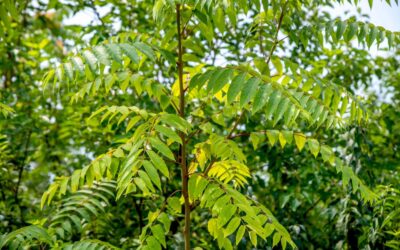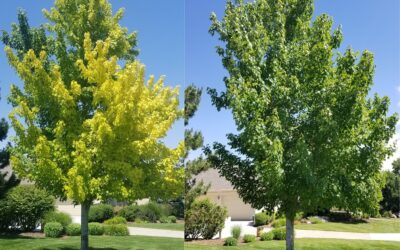There are many varieties of oak trees that grow in nearly every temperate part of the world. The bur oak (sometimes spelled burr) is part of the white oak group and is native to much of eastern North America. It’s a very rugged tree that is often planted in Colorado where it does well in our climate and soils and is tolerant of air pollution in urban areas.
Shady, Wide Canopy and Green, Glossy Leaves
Burr oaks are primarily planted as shade trees and do best when planted as specimens or widely spaced due to their thick, wide canopies. The bur oak reaches a mature height of 50-70 feet with a round, spreading canopy about 80% of its height. It has attractive dark green glossy leaves on branches that add extra interest in winter after its leaves turn a brownish yellow and drop in the fall.
Acorn Fruits
One of the most distinctive features of the bur and other oaks is their fruit—acorns. The acorns of the bur oak are the largest of any North American oak and are an important food source for many types of wildlife. Squirrels and jays store acorns in caches and black bears often rip off entire branches to collect enough nuts for a meal. Deer, pigs, horses and cattle also feed on acorns, but the tannins in acorns can be toxic to horses and cattle if eaten in large quantities. Deer, porcupine, and other browsers also feed on the leaves and tender shoots of oak trees.
Those same tannins have caused the otherwise nutritious acorn seeds to fall out of popularity with humans, who once relied on them as an important food source. The tannins can be leached out of chopped acorn seeds, but the effort involved has relegated them to a staple in relatively few diets, Korean and Native American among the ones that remain. But interest in natural foods has precipitated a minor revival in acorns, so many recipes can be found on the internet if you’re interested.
Popular Woodworker’s Tree
Oak is a very strong and workable wood, so it’s a favorite among builders and woodworkers. You see many varieties of white, red, and other oaks in all types of furniture and flooring.
Drought-Tolerant, Fire-Resistant, Pest-Free and Resilient
Bur oaks’ long taproots make them drought-tolerant and fire-resistant. Oaks are generally pest-free, and while galls (round protrusions on leaves or stems) can be unattractive, they don’t harm the trees. The bur oak is one of the hardiest varieties and can be found in places as inhospitable as Alaska and the Canadian Rockies.
If you’re planning to add a majestic bur oak or two to your landscape, or need maintenance of any existing trees or shrubbery, we offer planting, pruning, and shearing and insect and disease management services in the Denver area. Call us today for a free estimate at 303-623-8733.



